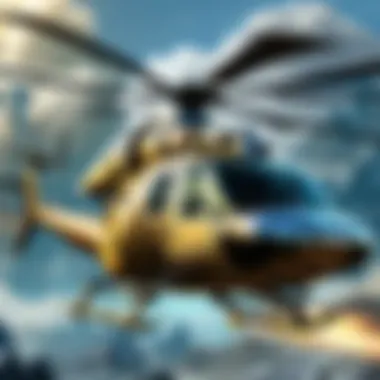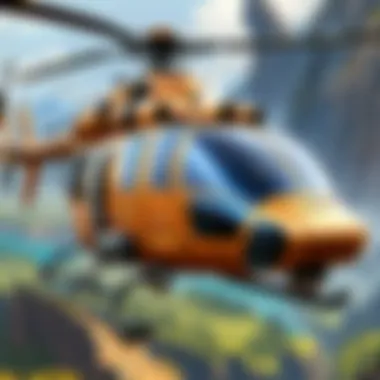The Evolution of Helicopter Technology: From Inception to Modern Innovations


Game Updates and Patch Notes
Helicopter technology has undergone a remarkable transformation over the years, revolutionizing the way we perceive aerial transportation. From its humble beginnings to the sophisticated machines we have today, the evolution of helicopters has been a story of innovation and engineering prowess.
Strategy Guides and Tips
As we delve into the intricate world of helicopter engineering, it becomes evident that rotor systems play a pivotal role in the functioning and efficiency of these aircraft. Understanding the aerodynamics and material science behind helicopter rotors is crucial to appreciating the ingenuity and complexity involved in their design.
Lore and Story Analysis
The history of helicopters is intertwined with the spirit of human ingenuity and the pursuit of pushing technological boundaries. Exploring the narrative of helicopter evolution allows us to appreciate the ingenuity and resilience of engineers and visionaries who have contributed to this field.
Mod Reviews and Add-ons
In the realm of helicopter engineering, advancements in technology have led to the development of various add-ons and modifications that enhance performance and safety. From novel avionics systems to cutting-edge materials, these enhancements are a testament to the continuous evolution and improvement of helicopter technology.
Introduction
Helicopters, a marvel of engineering ingenuity, have captivated the human imagination with their graceful flight and unparalleled maneuverability. In this exploration of helicopter technology's evolution, we embark on a journey through time, unveiling the remarkable advancements that have shaped these aerial wonders. From the early visionary concepts to the cutting-edge technological breakthroughs of today, the evolution of helicopters mirrors humanity's relentless pursuit of innovation and progress.
The significance of understanding the evolution of helicopter technology lies in appreciating the intricate fusion of science, engineering, and creativity that has sculpted these flying machines. This article serves as a comprehensive guide, offering insights into the foundational principles that underpin helicopter design and operation. By delving into the origins of helicopter concepts and tracing their development over the centuries, we gain a profound understanding of how these aerial vehicles have become indispensable tools in various fields, from military operations to civilian transport and emergency services.
Examining the early helicopter pioneers, such as Leonardo da Vinci and Sikorsky, provides us with a historical backdrop to comprehend the iterative process that has propelled helicopter technology forward. Each inventor and engineer, with their unique perspectives and innovative ideas, has contributed to the collective knowledge pool that continues to drive advancements in rotor systems, aerodynamics, avionics, and materials science. By dissecting these contributions, we unravel the tapestry of evolution that has transformed helicopters from rudimentary prototypes to sophisticated flying machines.
As we navigate through the realms of rotor systems, aerodynamics, avionics, and material science, we unravel the secrets behind the mechanics of flight and the harmonious interplay of engineering components that enable helicopters to defy gravity with elegance and precision. This deep dive into the intricacies of helicopter design not only broadens our technical understanding but also fosters an admiration for the human ingenuity that has conquered the skies with these versatile air vehicles.


In the subsequent sections of this article, we will delve further into the fundamental aspects of helicopter design, explore the recent technological advancements that are reshaping the industry, and ponder the future prospects that promise to revolutionize the capabilities of helicopters in the 21st century. By unraveling the evolutionary thread of helicopter technology, we aim to inspire awe and appreciation for these engineering marvels that continue to push the boundaries of aerial innovation.
Early Helicopter Concepts
In the realm of helicopter engineering, understanding the early concepts is crucial as it lays the foundation for the groundbreaking advancements that follow. Delving into the roots of helicopter technology provides a profound insight into how human ingenuity has shaped the evolution of aerial transport. Early helicopter concepts encompass a range of innovative ideas and theoretical principles that set the stage for the development of functional rotary-wing aircraft. By examining the historical progression of these concepts, we gain a deeper appreciation for the challenges and triumphs that have defined the trajectory of helicopter engineering.
Leonardo da Vinci's Designs
Leonardo da Vinci, the revered Renaissance polymath, made significant contributions to the field of aviation through his pioneering helicopter designs. Despite being conceptual in nature, da Vinci's sketches and manuscripts laid the groundwork for future inventors to explore the possibilities of vertical flight. His aerial screw, envisioned as a human-powered flying machine, exemplifies his visionary approach to aeronautical engineering. By elucidating da Vinci's designs, we uncover the innovative thinking that fueled the early stages of helicopter technology.
Sikorsky's Breakthrough
The name Sikorsky resonates deeply in the annals of helicopter engineering with Igor Sikorsky's revolutionary contributions to rotary-wing aircraft. Sikorsky's breakthrough moment came with the successful flight of the VS-300, marking a pivotal advancement in vertical flight capabilities. By introducing key innovations such as the main rotor configuration and anti-torque tail rotor, Sikorsky propelled helicopter technology into a new era of efficiency and stability. Exploring Sikorsky's breakthrough unveils the meticulous engineering prowess and tireless dedication that have defined the modern helicopter design principles we see today.
Fundamentals of Helicopter Design
In the grand scheme of understanding helicopter technology, grasping the fundamentals of helicopter design serves as the crucial cornerstone. The intricate details of rotor systems, aerodynamics, avionics, and materials directly correlate to the efficiency and functionality of helicopters. Without a solid grasp of these fundamentals, any discussion on the evolution of helicopter technology would be incomplete. The design considerations play a pivotal role in determining the maneuverability, stability, and overall performance of helicopters, making it imperative to delve into the nuances of each element.
Rotor Systems
Main Rotor
The main rotor in helicopter design stands out as a pivotal component that defines not only the lift generation but also the maneuvering capability of the aircraft. Its unique feature lies in its ability to generate lift while simultaneously allowing the helicopter to move in different directions. The inherent advantage of the main rotor is its versatility in providing vertical lift, enabling helicopters to hover and take off vertically, a hallmark characteristic for helicopters in this article on aviation marvels. Despite its prowess in lifting the aircraft, the main rotor also poses challenges such as complex control mechanisms and aerodynamic considerations that need to be carefully addressed for optimal performance.
Tail Rotor


The tail rotor, in contrast to the main rotor, serves a specific purpose of stabilizing the helicopter by counteracting the torque produced by the main rotor. Its key characteristic lies in its contribution to the anti-torque system, enabling the helicopter to maintain directional control and prevent uncontrollable spinning. This component is a valuable choice for this discussion as it enhances the safety and control of the helicopter, ensuring stable flight conditions. However, the tail rotor's disadvantage lies in its susceptibility to aerodynamic inefficiencies and mechanical complexities that can impact the overall performance of the helicopter.
Tandem Rotor
The tandem rotor configuration presents a distinctive aspect in helicopter design by incorporating two main rotors placed in tandem, one behind the other. This design offers unique benefits such as enhanced lifting capacity, increased stability, and improved control, making it a popular choice in heavy-lift helicopters. The tandem rotor's advantage in providing superior lift capabilities and stability makes it a topic of relevance in this article on the evolution of helicopter technology. Despite its numerous advantages, the tandem rotor system comes with drawbacks related to increased mechanical complexity and heightened maintenance requirements that need to be carefully considered.
Coaxial Rotor
The coaxial rotor system features two rotors mounted one above the other rotating in opposite directions. This design eliminates the need for a tail rotor, simplifying the aircraft's mechanical structure and enhancing efficiency. Its key characteristic of counter-rotating blades contributes to improved maneuverability and agility, making it a preferred choice for agile helicopters. The uniqueness of the coaxial rotor lies in its ability to provide exceptional control and maneuverability without the complexities associated with traditional tail rotor systems. However, the coaxial rotor system may face challenges in terms of increased mechanical stress on the airframe and higher production costs, factors that are significant in the context of helicopter technology evolution.
Aerodynamics
Aerodynamics play a pivotal role in determining the performance and efficiency of helicopters, making it a key focus in understanding helicopter technology evolution. The lift generation aspect of aerodynamics involves the generation of forces that lift the helicopter off the ground, enabling it to achieve flight. The unique characteristic of lift generation lies in its ability to create upward forces to counteract the gravitational pull on the helicopter, facilitating vertical takeoff and sustained flight. This aspect is particularly crucial for this article as it underlines the foundation of helicopter flight and its evolution over time.
Flight Control Systems
The flight control systems of helicopters encompass a range of components and mechanisms designed to facilitate pilot control, stability, and maneuverability. These systems play a vital role in ensuring safe and efficient helicopter operation by translating pilot input into precise movements of the aircraft. The key characteristic of flight control systems lies in their integration of sensors, actuators, and computer systems to maintain stable flight conditions and respond to pilot commands swiftly. This feature makes them a popular choice in modern helicopter designs, highlighting their significance in enhancing aviation safety and performance. However, flight control systems may encounter challenges related to system complexity, hardware malfunctions, and software vulnerabilities that can affect helicopter operation and safety.
Avionics and Navigation
Avionics and navigation systems form the technological backbone of modern helicopters, providing essential flight instruments, communication tools, and navigation aids for seamless aerial operations. Flight instruments play a critical role in displaying key flight parameters, engine data, and navigation information to the pilots, aiding in informed decision-making during flight. Communication systems enable effective interaction between pilots, air traffic control, and ground stations, ensuring clear and timely exchange of vital information. Navigation aids such as GPS and inertial navigation systems enhance route planning and position tracking, contributing to precise and efficient helicopter navigation. These technologies are crucial for the advancement of helicopter technology and are integral to the evolution of modern rotary-wing aircraft.
Materials and Construction
The materials and construction of helicopters are essential components that influence the performance, durability, and efficiency of these aerial vehicles. Composite materials, known for their high strength-to-weight ratio and corrosion resistance, offer superior structural integrity while reducing overall weight, enhancing fuel efficiency and flight performance. Titanium alloys, prized for their exceptional strength, heat resistance, and lightweight properties, find extensive use in critical components of helicopters, contributing to their structural robustness and longevity. Carbon fiber-reinforced polymers, lauded for their superior strength and durability, act as lightweight substitutes for traditional materials, enhancing overall performance and reducing maintenance requirements for helicopters. The unique features of these materials make them advantageous choices for helicopter construction, playing a significant role in the technological advances and evolution of rotorcraft over the years.


Technological Advancements
In the realm of helicopter technology, continuous advancements have been pivotal in enhancing performance, safety, and efficiency. Technological advancements mark a significant progression in elevating the capabilities of helicopters, pushing boundaries beyond conventional limitations. These progressions not only improve operational effectiveness but are also instrumental in ensuring pilot and passenger safety. Understanding the intricacies of technological advancements in helicopters is crucial for comprehending the evolution of this aerial marvel.
Fly-by-Wire Systems
Fly-by-wire systems represent a revolutionary leap in helicopter technology, transforming traditional mechanical control systems into digital interfaces. By utilizing electronic sensors and computers to interpret pilot inputs and adjust control surfaces, fly-by-wire systems enhance aircraft maneuverability, stability, and responsiveness. This technology replaces heavy, complex mechanical linkages with lightweight wires, thereby reducing the overall weight of the helicopter. Additionally, fly-by-wire systems offer increased redundancy and safety features, minimizing the risk of pilot error and enhancing flight safety. The integration of fly-by-wire systems in helicopters signifies a quantum leap in aviation technology, epitomizing precision, reliability, and adaptability.
Stealth Technology Integration
The integration of stealth technology in helicopters represents a paradigm shift in modern aerial warfare tactics. By incorporating advanced composite materials and aerodynamic design elements, stealth helicopters feature reduced radar cross-section, thermal signature, and acoustic footprint, rendering them less detectable by enemy surveillance systems. Stealth technology integration enhances operational effectiveness by enabling helicopters to conduct covert missions, evade enemy detection, and operate in hostile environments with minimal risk of detection. The seamless integration of stealth technology in helicopters underscores a strategic advancement in military aviation, ushering in a new era of stealth capabilities and tactical superiority.
Electrically-Powered Helicopters
Electrically-powered helicopters herald a new era of sustainable aviation, leveraging electric propulsion systems to reduce emissions, fuel consumption, and operational costs. By utilizing electric motors powered by rechargeable batteries or fuel cells, electric helicopters offer a cleaner, quieter, and more efficient alternative to traditional combustion engine helicopters. The advent of electrically-powered helicopters holds immense potential in revolutionizing urban air mobility, emergency medical services, and environmental sustainability in aviation. The integration of electric propulsion systems in helicopters exemplifies a progressive shift towards eco-friendly aviation solutions, emphasizing energy efficiency, environmental stewardship, and operational versatility.
Future Prospects
In the comprehensive exploration of helicopter engineering, the section on Future Prospects holds paramount significance as it casts a visionary lens on the trajectory of this aerial technology. Understanding the future of helicopters is crucial as it not only shapes the direction of research and development but also impacts various industries, including defense, transportation, and emergency services. Future prospects encompass a spectrum of advancements poised to revolutionize helicopter capabilities, ranging from enhanced autonomy to improved operational efficiency and sustainability. By delving into the evolving landscape of helicopter technology, we gain insights into the ongoing quest for innovation and optimization to meet the demands of a rapidly changing world.
Autonomous Flight Systems
The realm of Autonomous Flight Systems heralds a new era in helicopter engineering, revolutionizing aerial operations through the integration of advanced technology. Autonomous systems empower helicopters to navigate and perform tasks with minimal human intervention, marking a significant shift towards safer, more efficient aviation. By leveraging cutting-edge sensors, artificial intelligence, and decision-making algorithms, helicopters equipped with autonomous capabilities can execute missions with precision and agility, enhancing operational flexibility and mission success rates. The development of Autonomous Flight Systems underscores the relentless pursuit of enhancing aviation safety, optimizing resource utilization, and redefining the boundaries of manned and unmanned flight.
Vertical Takeoff and Landing (VTOL) Innovations
Vertical Takeoff and Landing (VTOL) Innovations epitomize the epitome of agility and versatility in helicopter design, offering a transformative approach to aerial mobility. By enabling helicopters to take off and land vertically without the need for runways, VTOL technology unlocks new possibilities for urban air mobility, emergency response, and specialized missions in confined spaces. The integration of VTOL capabilities enhances operational flexibility, reduces reliance on traditional infrastructure, and expands the reach of helicopter services to urban environments and challenging terrains. With VTOL innovations, helicopters embrace a dynamic paradigm shift towards on-demand, efficient transportation solutions that cater to evolving urban landscapes and mobility needs.
Hybrid-Electric Propulsion
In the realm of propulsion systems, Hybrid-Electric Propulsion emerges as a game-changing innovation poised to redefine the efficiency and sustainability of helicopter operations. By combining traditional combustion engines with electric power sources, hybrid-electric propulsion facilitates enhanced performance, reduced emissions, and lower operational costs. The integration of electric power technologies in helicopters not only enables quieter and cleaner flights but also enhances fuel efficiency and reduces environmental impact. As the aviation industry gravitates towards sustainability and eco-friendly practices, hybrid-electric propulsion stands out as a pioneering solution that aligns with the global shift towards greener aviation. The adoption of hybrid-electric propulsion signifies a strategic leap towards a more sustainable future for helicopters, underlining the progressive evolution of aerial transportation towards greater efficiency and environmental stewardship.







